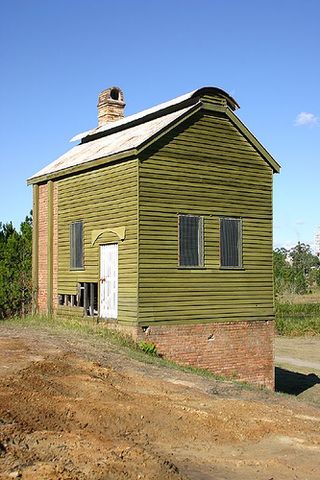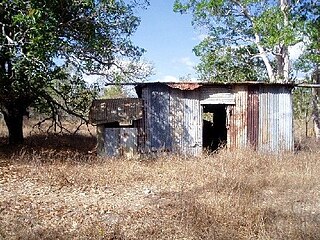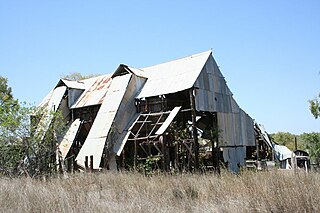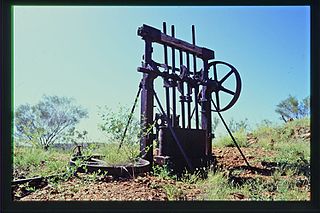
No. 1 Scottish Gympie Mine and Battery is a heritage-listed mine at Old Brisbane Road, Monkland, Gympie Region, Queensland, Australia. It was built from c. 1889 to c. 1923. It was added to the Queensland Heritage Register on 21 October 1992.

Norton Goldfield is a heritage-listed former mine at Norton Road, near Nagoorin, Boyne Valley, Gladstone Region, Queensland, Australia. It was built from 1870s to 1941. It is also known as Milton Goldfield. It was added to the Queensland Heritage Register on 27 October 2006.

Barclay's Battery is a heritage-listed stamper battery at Collinsville road, Mount Coolon, Whitsunday Region, Queensland, Australia. It was built from 1914 to 1932. It is also known as Mount Coolon Gold Mines Battery. It was added to the Queensland Heritage Register on 17 May 2004.

Wenlock Goldfield is a heritage-listed mine in Archer River, Shire of Cook, Queensland, Australia. It was built from 1892 to 1950s. It is also known as Batavia Goldfield and Lower Camp (Wenlock). It was added to the Queensland Heritage Register on 3 March 2006.

Ebagoola Township and Battery is a heritage-listed mining camp at Yarraden, Shire of Cook, Queensland, Australia. It was built from 1900 to 1913. It is also known as Ada Stewart Battery and Ebagoolah Township. It was added to the Queensland Heritage Register on 15 May 2006.

Alexandra Mine and Battery is a heritage-listed mine at Palmerville Station, Maytown, Shire of Cook, Queensland, Australia. It was built from c. 1878 to 1898. It is also known as Alexandra PC.It was added to the Queensland Heritage Register on 21 October 1992.

Wild Irish Girl Mine and Battery is a heritage-listed mine at Conglomerate Range, Maytown, Shire of Cook, Queensland, Australia. It was built from c. 1894 to 1980s. It is also known as Emily Battery. It was added to the Queensland Heritage Register on 21 October 1992.

Gordon's Mine and Mill is a heritage-listed mine at Iron Range, Shire of Cook, Queensland, Australia. It was built from c. 1936 to 1950s. It is also known as Iron Range Mine and Mill. It was added to the Queensland Heritage Register on 13 December 2002.

Kingsborough Battery is a heritage-listed mining building off the former East Street, Kingsborough, Thornborough, Shire of Mareeba, Queensland, Australia. It was built from c. 1896 to 1990s. It was added to the Queensland Heritage Register on 21 October 1992.

General Grant Mine is a heritage-listed mine off Dimbulah–Mount Mulligan Road, Kingsborough, Shire of Mareeba, Queensland, Australia. It was built from c. 1878 to the 1930s. It was added to the Queensland Heritage Register on 21 October 1992.

Tyrconnel Mine and Battery is a heritage-listed gold mine between Kingsborough and Thornborough, Shire of Mareeba, Queensland, Australia. It was built from 1876 to 1980s. It was added to the Queensland Heritage Register on 21 October 1992.
Lolworth Creek Battery is a heritage-listed stamper battery at Basalt, Charters Towers Region, Queensland, Australia. It was built from c. 1930 to c. 1932. It was added to the Queensland Heritage Register on 14 June 2003.

Mining works on Towers Hill is a heritage-listed group of mining ruins at Towers Hill, Charters Towers, Charters Towers Region, Queensland, Australia. They were built from 1872 to 1940s. They are individually known as Pyrites Works, Rainbow Battery, and Towers Chlorination Works. They were added to the Queensland Heritage Register on 29 April 2003.
Aspasia Mine and Battery is a heritage-listed mine and stamper battery at Gulf Developmental Road, Georgetown, Shire of Etheridge, Queensland, Australia. It was built from 1916 to 1952. It is also known as Mount Turner Battery. It was added to the Queensland Heritage Register on 13 April 2006.

Kidston State Battery is a heritage-listed stamper battery at Kidston in Einasleigh, Shire of Etheridge, Queensland, Australia. It was built from 1907 to 1950. It is also known as Kidston Township. It was added to the Queensland Heritage Register on 21 October 1992.

Content Mine is a heritage-listed former mine at Gulf Developmental Road, Croydon, Shire of Croydon, Queensland, Australia. It was built from 1887 to 1918. It is also known as Content Block Mine. It was added to the Queensland Heritage Register on 4 July 2006.

Richmond Mine and Battery is a heritage-listed mine at Gulf Developmental Road, Croydon, Shire of Croydon, Queensland, Australia. It operated from 1886 to c. 1916. It was added to the Queensland Heritage Register on 28 July 2006.

Golden Gate Mining and Town Complex is a heritage-listed mining camp at Normanton Road, Croydon, Shire of Croydon, Queensland, Australia. It commenced in 1886. It is also known as Golden Gate Township, Croydon Consols Pump Shaft, Golden Gate No.10 North Mine, Golden Gate Cemetery, Croydon Consols Battery and Cyanide Plant, and Golden Gate Mine. It was added to the Queensland Heritage Register on 14 August 2009.

Bower Bird Battery is a heritage-listed former stamper battery in the Mount Isa Mining District, Mount Isa, City of Mount Isa, Queensland, Australia. It was built from c. 1895 to c. 1909. It was added to the Queensland Heritage Register on 13 December 2002.

Ravenswood Mining Landscape and Chinese Settlement Area is a heritage-listed former mining town and archaeological site on the reserve bounded by School Street, Cemetery Road, Railway Street and Burdekin Falls Dam Road, Ravenswood, Charters Towers Region, Queensland, Australia. It was added to the Queensland Heritage Register on 14 October 2016.





















